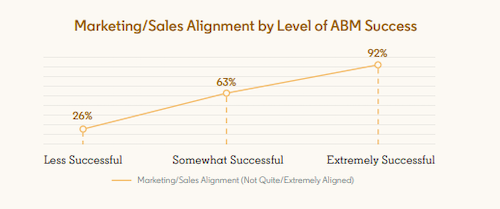Account-Based Marketing Stats Every Strategist Should Know
A wise person once observed that, generally speaking, whatever comes easy doesn't last, and whatever lasts doesn’t come easy.
Admittedly, this adage may seem like an odd choice for starting a post about account-based marketing (ABM). After all, we’re talking about a customized strategy which, by definition, is not supposed to “last” beyond any one target account.
But zoom back a bit, and it becomes apparent that ABM – the high-level approach anyway – is becoming the clear choice for B2B leaders who demand some semblance of lasting success.
Bigger deals don’t just keep entering the pipeline for no reason. Nor do they suddenly start closing faster, or at a higher rate. None of that happens on its own. These outcomes require concerted effort.
The true beauty of ABM is that it forces B2B teams to finally confront two aspects of sales and marketing that most commonly block the path to success:
- Not having a focused framework for engaging B2B buying committee members.
- Not having a clear plan for when and how marketing and sales will collaborate.
Any serious attempt at implementing ABM will include a framework for engaging stakeholders and a plan for collaborating with sales. And while you might miss the mark with some of your efforts initially, failing can be a good thing because it leads to learning and long-term improvement. The more you’re testing and measuring, the more likely you are to find those foundational truths from which to expand your ABM kingdom.
For years, we’ve had a pretty good feeling that ABM is the future, that it makes too much sense to ignore. So most of us have made it a point to piecemeal an ABM approach alongside those less customized practices that still manage to pull in leads, albeit less and less reliably.
The big wins haven’t come easy, but they have come. Soon we’ll see more and more B2B sellers and marketers achieving breakthroughs in sustainability and scalability. If the stats below are any indication, it appears we may be on the precipice of an ABM tipping point. Here are more than 20 stats that speak to the currenr state of ABM:
Though More Than Half of B2B Marketers Are Now Account-Based Marketers, Few Have Reached Elite Territory
LinkedIn surveyed over 800 B2B marketers globally and found that well over half of them (56%) are using account-based marketing in their current business operations. Over 80% of those surveyed said they plan to boost their budget for ABM over the next year.
As of late 2019, only 17% of B2B marketers described their ABM program as an embedded driver of strategic growth. (eMarketer)
In 2018, 43% of B2B marketers rated their ABM strategy as “established.” One year later, that figure jumped to 55%. (Forrester)
Takeaway: As nearly all ABM programs have now transitioned from theory to practice, the next challenge for sales and marketing teams is to make sure that, from the customer’s perspective, they're doing ABM in a way that is laser-focused in their efforts.
ABM Continues to Produce Larger Deals That Are More Likely to Close
Nearly three-quarters (74.6%) of B2B sales to new customers take at least four months to close. Nearly half (46.4%) take seven months or more. (CSO Insights)
After instituting ABM, companies saw a 171% increase to their average contract value ($195,294 vs. $71,941). (TOPO and ABM Leadership Alliance)
91% of ABM marketers said their ABM accounts had a bigger deal size, with a quarter of respondents reporting deal sizes at least 50% larger for ABM accounts. (SiriusDecisions)
86% of B2B companies said ABM improved their win rates. (TOPO)
Takeaway: As buying committees get bigger and decisions get more complex, B2B marketers are leaning into ABM as a way to secure more revenue from fewer customers. By having a better definition of who they are best positioned to serve, many companies are also leveraging ABM as a way to reduce demands related to managing a wide variety of customer types.
Not Every Organization Is Measuring the ROI of ABM, But For Those Who Do…
“Revenue won” is the most common metric marketers use to track ABM. (LinkedIn)
87% of marketers who measure ROI say ABM outperforms every other marketing investment. (ITSMA)
89% of organizations able to report ROI said ABM accounts achieved a higher ROI than a non-ABM supported control group. 30% of these organizations reported ROI to be at least 21% higher. (SiriusDecisions)
ABM Facilitates Team Collaboration, Customer Engagement
30% of marketers working in an account-based manner reported engaging 2x more frequently with their C-level targets. (The SiriusDecisions Command Center)
85% of marketers with a service-level agreement (SLA) think their marketing strategy is effective. (HubSpot)
82% of B2B marketers said ABM greatly improves the alignment between marketing and sales at their company. (LinkedIn)
A company’s level of marketing and sales alignment typically shows a strong correlation with its level of ABM success. (LinkedIn)
Takeaway: If your sales and marketing teams struggle to see eye to eye, a jointly pursued ABM program may be the perfect way to promote collaboration-fueled performance gains.
ABM Budgets and Personnel Continue to Expand
On average, ABM budgets account for 36% of digital marketing spend and are growing 9% annually. (LinkedIn)
69% of ABM top performers now have a dedicated ABM leader at their organization. (TOPO)
Takeaway: As ABM Leadership Alliance’s research shows, the most effective ABM programs are investing more in the areas of data and analytics, which includes people to oversee their management.
ABM Ages Well
84% of marketers said ABM provided significant benefits to retaining and expanding existing relationships. (Alterra Group)
80% of B2B companies report that ABM increases their customer lifetime value. (TOPO)
At organizations where sales and marketing teams are tightly aligned, customer retention rates are 36% higher. (MarketingProfs)
According to ABM Leadership Alliance’s ABM 2019 Benchmark Study, top business benefits of ABM include improvements in:
- Account engagement
- Brand perception
- Pipeline and revenue growth
- Customer satisfaction
Takeaway: Marketers often fail to give themselves full credit for their work when they measure ROI too quickly. With ABM, in most cases, the longer you measure, the stronger your ROI, and so is your case for additional budget.
Challenges Remain Concerning Data Accuracy and Ease of Customization
40% of B2B marketers still find it challenging to develop the right content for their target audience. (LinkedIn)
43% said unreliable data makes it hard to know who to target within accounts. (LinkedIn)
42% struggle to personalize content at scale for target accounts. (LinkedIn)
Takeaway: To realize the promise of ABM, B2B marketers need solutions that allow for the easy prioritization of accounts based on key parameters. Then, marketers need the ability to dynamically deliver relevant content to the exact people who influence decisions at those accounts.
As far as ABM is concerned, where should B2B marketers go from here?
Whatever your situation, and whatever you decide, Demandbase CMO Peter Isaacson implores you to proceed with urgency: “In a hyper competitive landscape, B2B marketers have recognized they can’t afford to delay the implementation of ABM any longer,” he says. “The dramatic increase in both budgets and adoption demonstrates ABM continues to become a mainstream business strategy.”
Don’t delay your ABM ambitions another day. Get started toward your next iterative improvement with help from our guide, A B2B Marketing Jumpstart to Account-Based Marketing.






